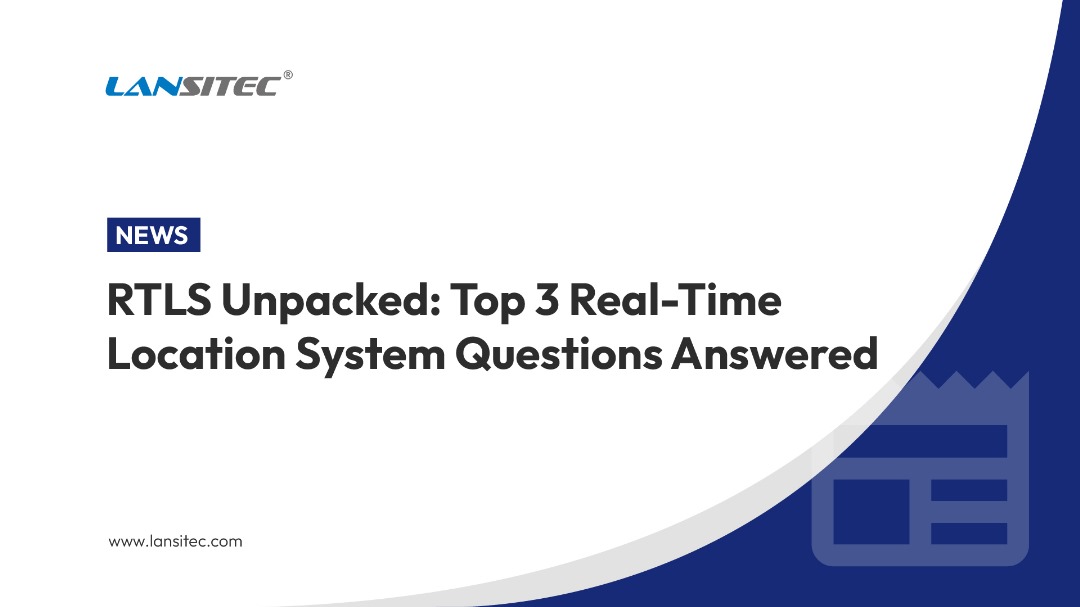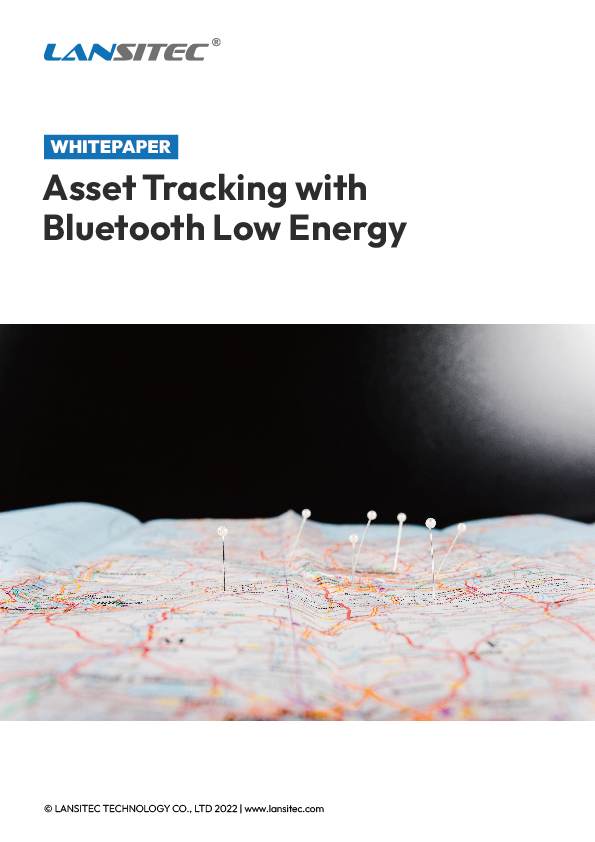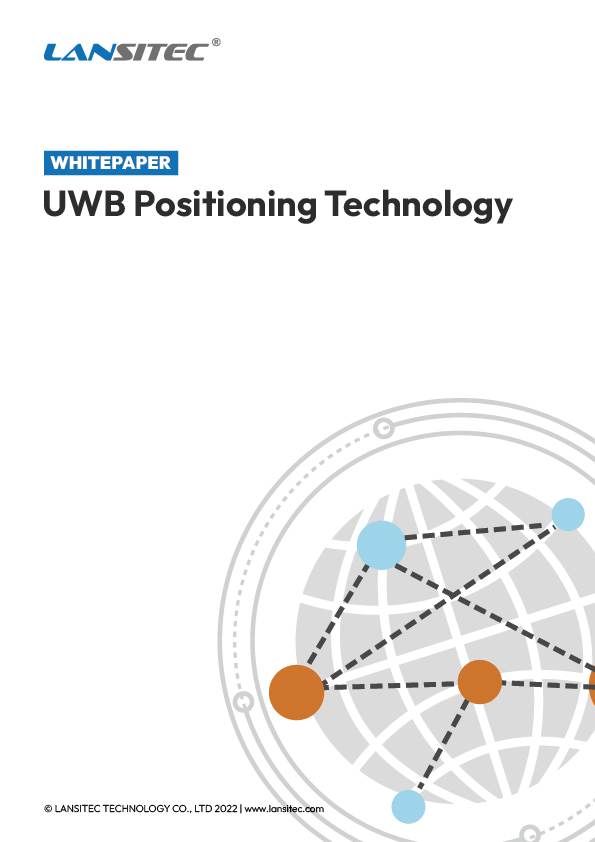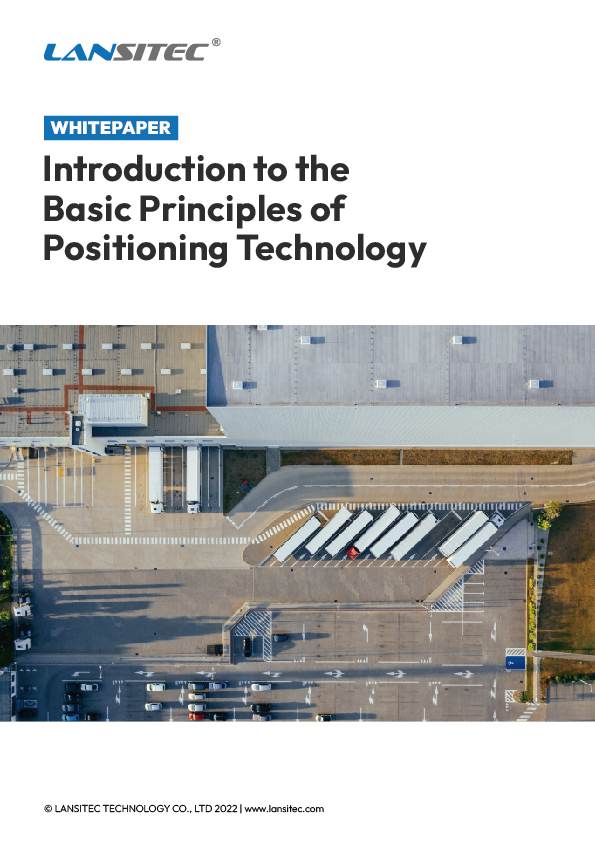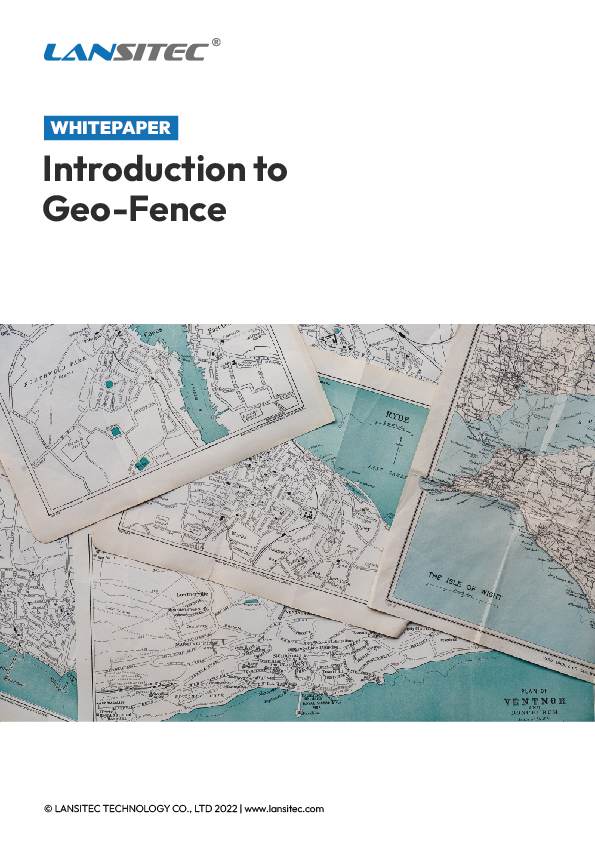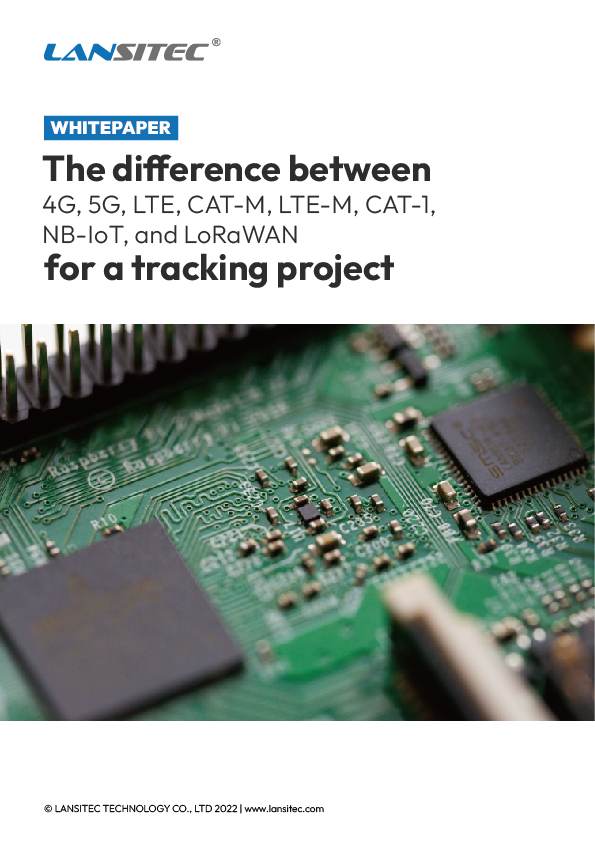Real-Time Location Systems (RTLS) have rapidly moved from tech buzzword to real-world game changer across industries. Imagine a hospital that can instantly locate a critical ventilator, or a factory where tools never go “missing” on the shop floor. These are the kinds of problems RTLS technologies solve every day. Yet, for many system integrators and business owners, RTLS still feels like a complex new frontier. What exactly is it? How does it work? And what value does it truly deliver? In this blog post, we’ll answer the top three questions people are asking about RTLS. Along the way, we’ll highlight practical examples (including solutions from Lansitec) to show how RTLS can elevate safety, efficiency, and visibility in your operations. Let’s dive in!
What is a Real-Time Location System (RTLS) and How Does It Work?
Defining RTLS
أ Real-Time Location System (RTLS) is a technology setup that continuously tracks the location of objects or people in real time within a defined area. In simple terms, it’s like GPS for your indoor (and even outdoor) assets, using a combination of wireless tags, sensors, and software to pinpoint where things are at any moment. Unlike basic barcode or RFID scans that only tell you an item was somewhere at a past time, RTLS gives you live location data. It can utilize technologies such as RFID, Wi-Fi, Bluetooth Low Energy (BLE), Ultra-Wideband (UWB), GPS, and others to achieve this real-time tracking. The goal is immediate visibility: you attach a tag to whatever you want to track, and the system shows you where that tag is in real time on a digital map or dashboard.
How RTLS works – key components
Behind the scenes, any RTLS deployment has a few core pieces working together:
- Wireless Tags/Transmitters: These are small devices (badges, stickers, sensors, etc.) that you attach to assets or wear on personnel. They continuously emit a unique signal (via Bluetooth, UWB, Wi-Fi, etc.) identifying themselves. Tags can be active (battery-powered, sending out regular signals) or passive (powered by reading devices, like classic RFID badges). For example, a Lansitec متتبع شارة LoRaWAN is an active tag that looks like a standard ID card a person can wear, broadcasting its ID and sensor data at intervals. Some tags even include sensors for things like motion, temperature, or a panic button for emergencies.
- Anchors/Receivers (Infrastructure): These are the detectors placed around the environment that “hear” the signals from the tags. Depending on the technology, they might be fixed antennas/readers (like UWB anchors or BLE gateways in various zones) or even other mobile devices. The infrastructure could include Lansitec Bluetooth Gateways placed in offices, hallways, or warehouses to pick up signals from BLE tags, or UWB anchors spaced around a facility for high-precision tracking. These receivers capture the tag’s signal and often also note the signal strength or time-of-flight, then forward this data to the central system (often over Wi-Fi, Ethernet or even LoRaWAN). For instance, Lansitec’s LoRaWAN UWB Anchor units use UWB radio to measure distances to tags and then use long-range LoRaWAN to send those readings back to a server (Lansitec_Product Catalog_EN v8.7.7.pdf) – this minimizes cabling and allows wide coverage with just a few gateways.
- Software Platform: All the collected data goes into an RTLS software platform, which computes the exact location of each tag and presents it to users. The software uses algorithms to triangulate positions (if multiple anchors hear a tag) or to map proximity (if a tag is nearest one reader). The result is typically a visual dashboard: a floorplan with moving dots representing equipment and people, along with alerts and analytics. The RTLS software is the “brain” – it can log historical movements, generate reports, and send alerts (e.g., if an asset leaves a zone or a person presses a duress button). It might integrate with other systems too, like sending location data to a hospital’s equipment management system or a warehouse’s inventory database.
An example of a modern RTLS tag: Lansitec’s LoRaWAN Badge Tracker looks like a regular ID card you wear on a lanyard. This sleek, battery-powered tag combines Bluetooth and GPS with LoRaWAN connectivity, automatically switching between indoor and outdoor tracking. In an office or hospital, it can use Bluetooth for room-level accuracy, and when outdoors it activates GPS for precise positioning – all while sending updates over long-range LoRaWAN without needing Wi-Fi or cellular plans. Such tags enable real-time visibility of staff or assets as they move everywhere from basement corridors to open yards.
Bringing it together
When you deploy an RTLS, you might place anchors at strategic points (ceilings, walls, gateways around a site) and give out tags to whatever you need to track (e.g. attach them to forklifts, hospital beds, ID badges for workers, pallets, tools, etc.). The moment a tagged item moves, the nearest receivers detect it and the software updates the item’s location on your screen. For example, suppose a warehouse uses RTLS: a small Lansitec BLE beacon tag is fixed to each pallet, and Bluetooth receivers are installed in each zone of the warehouse. As a pallet is carried by a forklift, the system automatically logs which zone it’s in and even which forklift moved it (if the forklift has a tag too!). By the time the pallet reaches the loading dock, managers already see its journey and current position in real time. In short, RTLS gives you live, automatic “find my stuff” superpowers. No more manual scanning or searching – the system continuously watches over your important assets for you.
What Are the Key Benefits and Use Cases of RTLS?
Implementing an RTLS isn’t just about tech for tech’s sake – it’s about solving real-world problems. Organizations of all kinds are asking “Is investing in RTLS worth it?” The answer can be a resounding yes when you consider the concrete benefits. Let’s break down some of the major value points and use cases, from saving time and money to enhancing safety:
- Stop Wasting Time Looking for Assets: One of the most immediate benefits of RTLS is ending the scavenger hunts for equipment or tools. Think about how often staff spend minutes (that add up to hours) searching for a misplaced device, a specific container, or even a colleague. Studies show RTLS can reduce search times by up to 90% (The ROI of Asset Tracking with RTLS | Litum). For example, nurses traditionally waste significant time hunting down IV pumps or wheelchairs; with RTLS, they can pull up a map and see exactly where the nearest free pump is. This means more time caring for patients and less time walking halls. In a manufacturing plant or warehouse, the same principle applies – if a worker can’t find a required tool or part, production stalls. RTLS eliminates those delays by giving instant visibility. An organization with 100 employees spending a couple hours a week searching could save hundreds of man-hours (one calculation showed saving 90% of search time equated to $225,000 annually in labor for a mid-sized company). In short, time previously lost is now time gained for productive work.
- Prevent Asset Loss and Theft: RTLS dramatically improves asset accountability. When every important piece of equipment is tagged and tracked, it’s much harder for items to go missing. Hospitals, for instance, face the constant issue of portable devices (pumps, monitors, wheelchairs) drifting between departments or even disappearing. With RTLS, you can set up geofence alerts that notify you if an item leaves its designated area or is taken through an exit unauthorized. Businesses report a 30–50% reduction in asset loss or theft after implementing RTLS tracking. One real-world case: Piedmont Healthcare implemented RTLS asset tracking across its hospitals and saved over $2 million by avoiding replacement purchases and optimizing equipment use. That’s money that would have been spent replacing “lost” tools – now saved by never losing them in the first place. For theft prevention, an RTLS tag on, say, a high-value piece of machinery can trigger an alarm if it’s moved offsite or after hours. Lansitec’s rugged متتبع الحاويات devices are used in supply chain and logistics for this reason – they not only pinpoint container locations in real time (indoor or outdoor), but also alert if a container is opened or goes out-of-bounds, greatly deterring theft and improving recovery rates.
- Enhance Safety and Security: RTLS isn’t just about things – it’s about people. In high-risk workplaces like construction sites, mines, or even large campuses, knowing where your people are can be critically important. RTLS badges carried by workers can function as safety devices. For example, Lansitec’s متتبع الشارة has a built-in motion sensor that detects falls or man-down events. If a worker slips and is knocked unconscious in a remote corner of a facility, the badge can automatically send an alert with their location. Similarly, many RTLS tags have an SOS button; a staff member under duress (say, a nurse facing an aggressive patient or a lone warehouse worker who feels unsafe) can press a button on their wearable tag to summon help, transmitting their exact location to security personnel. In healthcare, infant tracking tags are used in maternity wards to prevent baby abductions or mismatches – an alarm will sound if an infant tag is carried beyond authorized zones. Wander management in dementia care is another life-saving use: patients prone to wandering can wear discreet RTLS wristbands that alert staff if they approach exits or leave safe areas, preventing dangerous elopement. On the security side, RTLS can restrict access: if an unauthorized person (no tag or invalid tag) enters a restricted zone, the system knows and can notify security or trigger locks. All these examples illustrate how real-time location tech adds an invisible safety net over facilities, keeping people safe through instant awareness and response.
- RTLS in action for healthcare: A nurse locates a vital piece of equipment in a hospital corridor. In medical environments, RTLS solutions have been shown to improve staff efficiency and patient care by ensuring the right equipment is at the right place at the right time. By tracking assets like IV pumps, monitors, and wheelchairs, hospitals can save nurses countless hours – one study noted nurses spend up to 10% of their time just searching for equipment, a figure that RTLS can dramatically reduce. The result is not only cost savings, but also better patient outcomes when needed tools are always quickly found.
- Streamline Operations & Workflow: Beyond finding things and people, the data that an RTLS generates can be a goldmine for process improvement. When you know who أو what is where (and when) throughout the day, you can analyze bottlenecks and optimize workflows. For instance, in a busy emergency department, RTLS can track patient wait times and movements – if the system shows patients consistently queue at the X-ray department, maybe adding another machine or changing scheduling would help. In manufacturing, RTLS on forklifts and materials can reveal how goods flow through a plant: perhaps a particular part spends too long waiting at a certain station, indicating a process inefficiency. By visualizing these patterns, managers can reorganize layouts or staffing to improve throughput. One aerospace factory used RTLS to monitor work-in-progress items and saw a 3% efficiency gain by identifying idle time in their process. It may sound small, but in large-scale production that’s huge. Warehousing and logistics operations similarly use RTLS to implement just-in-time handling – knowing exactly when a pallet left storage and arrived at loading docks can help optimize truck scheduling and reduce dwell times. Essentially, RTLS provides real-time analytics of physical operations, which can be as powerful as the data analytics e-commerce companies use for their online user flows. Optimized workflow means higher productivity and a stronger bottom line.
- Improve Customer Experience: While this benefit is a bit more indirect, it’s worth noting. When businesses can locate assets and people quickly and run more efficiently, customers benefit too. In retail, RTLS can support better store experiences – for example, tracking shopping carts or customer movement (anonymously via signals) can help optimize store layout and reduce checkout wait times. In hospitality (hotels, theme parks, resorts), RTLS badges let staff know where VIP guests are so they can offer timely service, or even enable location-based requests (“bring my poolside drink to where I’m standing”). In healthcare, quicker service because equipment is available or staff can be found means patients get attended to faster, improving satisfaction. Even something like an airport can use RTLS for asset management (e.g., luggage carts, wheelchairs for disabled passengers) to ensure travelers always find what they need without delay. Smoother operations in the background lead to happier customers in the foreground.
Real-world examples abound
RTLS is already delivering value in many sectors. We’ve mentioned healthcare (patient tracking, asset management, infant safety) and manufacturing (tool tracking, work-in-progress monitoring). In الخدمات اللوجستية, companies use RTLS tags on trailers and containers to get end-to-end visibility of shipments – knowing not just that a container left the port, but exactly which warehouse lot it’s parked in and for how long. مواصلات providers use it for fleet tracking and yard management (tracking buses, trucks, or forklifts around large yards in real time to avoid congestion and idle time). Retail and supermarkets employ RTLS for smart shopping carts and inventory tracking (imagine being able to instantly locate that one last pallet of holiday goods in a regional distribution center). In sports and events, RTLS wristbands can track crowds for safety (monitoring flow and avoiding dangerous overcrowding) or enhance fan experience (e.g. locating friends or interactive treasure hunts). The versatility is endless: if knowing “where and when” something is would solve a problem in your operations, that’s where an RTLS could help.Finally, it’s worth noting that RTLS can often leverage existing infrastructure, which eases adoption. For example, some systems use a facility’s existing Wi-Fi network to locate Wi-Fi enabled tags (no new hardware needed, just software). Others, like Lansitec’s solutions, use low-power LoRaWAN gateways that can cover an entire facility or yard with just a handful of devices, rather than dozens of short-range readers (Lansitec_Product Catalog_EN v8.7.7.pdf). This means even large-scale deployments can be cost-effective and scalable. The bottom line: RTLS brings tangible, measurable benefits – from cutting search times and losses (saving money) to protecting people and streamlining workflows (saving lives and making work easier). It’s a foundation for smarter, more responsive operations in nearly any context.
How Do I Choose the Right RTLS Technology for My Needs?
Now that we know what RTLS is and why it’s beneficial, the next big question is usually: “How do I implement it? There are so many options – which RTLS technology or system should I use?” This is a crucial question, especially for system integrators who must pick the optimal solution for a given project. RTLS is not one-size-fits-all; the “right” choice depends on your specific requirements and constraints. Here are some key considerations and decision points to guide you:
- Accuracy Requirements: Start by determining how precise the location data needs to be for your use case. Different RTLS technologies offer different accuracy levels. Ultra-Wideband (UWB) is the gold standard for precision – it can locate tags within 10–30 centimeters accuracy in ideal conditions. This is fantastic for use cases like surgical tool tracking, social distancing alert systems, or high-speed robot coordination, where knowing exact positions is critical. However, UWB infrastructure can be more costly and require more anchors to blanket an area. Bluetooth Low Energy (BLE), on the other hand, typically gives you accuracy on the order of a few meters (often ~1–5 m in practice). That may sound less impressive, but for many applications like asset tracking in a warehouse or monitoring staff in an office, meter-level accuracy is perfectly sufficient. If you just need to know which room or zone something is in (not its exact spot within the room), BLE-based RTLS is a cost-effective choice. Wi-Fi RTT (Round Trip Time) and some proprietary RF systems fall in a similar mid-accuracy range of 1–5 m. GPS/GNSS is great for outdoors (typical accuracy 2–5 m under open sky) but doesn’t work indoors. In short: match the tech to the needed accuracy. For most general asset tracking, a system like Lansitec’s متتبع شارة LoRaWAN (which uses BLE for indoor and GPS for outdoor tracking) achieving ~1–3 m accuracy indoors is more than enough. But if you needed centimeter-level tracking (say, tracking athletes on a field or forklifts in a dense warehouse to avoid collisions), you’d lean toward a UWB solution. The good news is you can also mix technologies – for instance, use GPS outdoors and switch to UWB indoors. In fact, Lansitec’s UWB system is LoRaWAN-based, meaning you can deploy UWB for high precision on site and still cover wide areas via LoRa, blending precision and range.
- Coverage Area and Range: Consider the physical size and characteristics of the area you need to cover. Is it a single building, a campus, an underground mine, or a sprawling outdoor yard? Different RTLS approaches have different range capabilities. النطاق العريض للغاية has a relatively short range per anchor (typically ~30–50 meters radius per anchor in indoor settings). BLE beacons have a range of up to 30–50 meters as well, potentially more in open spaces, but accuracy might drop at the edges. Wi-Fi based locating uses your Wi-Fi access points – range similar to Wi-Fi (several dozen meters). لوراوان and other LPWAN technologies, however, are designed for long range. A single LoRaWAN gateway can listen to tags kilometers away (under ideal conditions). In urban environments one gateway might cover 1–2 km, and in open areas far more. This makes a huge difference for large facilities or multi-site operations – you might cover an entire shipyard or farm with just a couple of gateways. Lansitec leverages this by using LoRaWAN as the backbone for its RTLS: for example, a Lansitec LoRaWAN gateway can handle signals from hundreds of tags (500+ devices per gateway is supported) over a wide area. This drastically reduces infrastructure cost if you need broad coverage. So, if your use case is tracking vehicles across a 10-acre logistics yard, a LoRaWAN-based RTLS with GPS tags might be ideal. Conversely, if it’s a single building with many walls (which can block signals) and you need room-level granularity, you might deploy more, shorter-range anchors (BLE or UWB) in each room. Always plan for the radio environment: metal walls, machinery, or dense shelving can affect signal range, so choose a tech that can either cover it or allow enough anchor density to overcome it.
- Power and Battery Life: Different tag technologies have different power needs, which translate to battery size and life (or whether a tag can be passive with no battery). If you need tiny, long-lasting tags, that might push you toward certain solutions. Passive RFID tags, for instance, have no battery at all – but they only work when they pass by a powered reader, so they’re not true real-time trackers (more for point-in-time identification). Active tags (BLE, UWB, Wi-Fi, etc.) have batteries. UWB tags typically consume more power because of the rapid, precise pulses and calculations – a small UWB badge might last a few months on a charge, or longer if it’s a bigger battery or uses sparse updates. BLE tags are very power-frugal; some BLE beacons can last 3-5 years on a coin-cell battery, especially if they only broadcast periodically. If your scenario needs ultra-long tag life and you can tolerate a location update every few seconds or minutes, BLE is great. Lansitec’s BLE-based tags and LoRa trackers often boast multi-year battery life (for example, their متتبع الماكرو has a battery that can last 3+ years while doing regular GPS and BLE reporting. On the other hand, if you’re okay recharging tags every week or swapping batteries monthly (like for high-value assets or VIPs where you need UWB accuracy), that trade-off might be worth it. It’s all about balancing maintenance overhead vs. performance. Also consider if tags can be powered by an external source – e.g., tracking a powered vehicle allows the tracker to draw from the vehicle’s battery, so tag battery life might not be an issue there.
- Infrastructure and Integration: Evaluate what infrastructure you already have and whether the RTLS can leverage it. If a site has dense Wi-Fi, maybe a Wi-Fi RTT-based solution would be simplest (no extra anchors). If you want minimal new wiring, consider systems like Lansitec’s that use wireless gateways (LoRaWAN anchors can be solar or battery-powered, needing no ethernet cables at all). Also think about how the RTLS will integrate with your existing software. Many modern RTLS platforms offer APIs or integrations to feed data into ERPs, MES (Manufacturing Execution Systems), hospital management systems, etc. Ensure the vendor or solution you choose can interface with your dashboards or produce the reports you need. System integrators often prefer solutions that are interoperable and standards-based (for example, an RTLS that outputs data in a standard format like MQTT or HTTP so it can talk to IoT platforms easily). Lansitec’s solutions, for instance, focus on open connectivity – their tags communicate over standard LoRaWAN protocol, which can be captured by any LoRaWAN-compliant network server, and then integrated with cloud applications. Integration also includes physical installation considerations: if installing a solution in an old building, wireless (battery-powered) anchors can be a big advantage over running new power outlets everywhere. Scalability is another factor – if you plan to start small but later scale up to more sites or more tags, choose a system architecture that can grow (additional anchors, server capacity, etc.) without a complete redesign.
- Cost Considerations: Finally, budget will influence the choice. Generally, UWB hardware is more expensive than BLE; more anchors = more cost; active tags cost more than passive ones (but passive systems might require more reader portals). Do a rough cost-benefit analysis: How many tags and anchors will you need? Some solutions might have license costs for software. Others, like purely open-source or hardware-centric solutions, might let you manage the data yourself to save on recurring costs. Lansitec’s approach using LoRaWAN can reduce ongoing costs by eliminating cellular data fees (since LoRaWAN has no subscription cost), which is a subtle but important saving if you would otherwise put a SIM card in every tracker. Also, consider that RTLS often delivers ROI through the savings we discussed earlier (time, loss prevention, etc.). Still, if two technologies both meet your needs, the less expensive one (in terms of combined device + infrastructure + maintenance costs) is naturally preferable. Sometimes a hybrid approach is most cost-effective: use an expensive high-precision system only where needed (critical zones) and a cheaper tech elsewhere. For example, you might put UWB in a small area for precise tracking of a surgical process, but use BLE in the rest of the hospital for general asset tracking – all feeding into one software platform.
In summary, choosing an RTLS is about matching the technology to your problem. Ask yourself: Do I need pinpoint (cm) accuracy or just room-level? Indoor only or indoor+outdoor? How large is the area? Do tags need to be tiny or have ultra-long battery life? Are we okay installing new hardware, or do we need to piggyback on what’s there? By answering these, the right solution often becomes clear. The great thing is many modern RTLS offerings, like those from Lansitec, cover multiple bases. For instance, Lansitec’s حلول تتبع النطاق العريض للغاية can achieve ~10 cm accuracy for real-time indoor positioning, while their بي-موبايل® hybrid solution combines GPS, BLE, and LoRaWAN to seamlessly track assets as they move from indoors to outdoors and over long distances. This means you don’t necessarily have to pick one technology and stick to it – you can deploy a mix under one umbrella. A savvy system integrator might use long-range LoRaWAN tags for vehicles in a yard, BLE beacons for tools in the workshop, and UWB for a high-value assembly station – all integrated together. Lansitec’s platform is designed to handle such heterogeneous setups, so you get the best of all worlds: the coverage and scale of LoRaWAN with the precision of UWB where needed. Ultimately, the right RTLS is the one that solves your specific problem in the most efficient way, and with today’s flexible systems, you have a toolkit to choose from rather than a single hammer for every nail.
Real-Time Location Systems are transforming how we manage assets and people in practically every field. We’ve answered the top questions – what RTLS is, why it’s valuable, and how to choose the right approach. The common thread is clear: RTLS brings visibility. In today’s fast-paced world, real-time visibility is the key to efficiency, safety, and smart decision-making. Whether you’re a system integrator designing a solution for a client, or a facility manager tired of losing track of equipment, RTLS can be a game-changer in solving your challenges.
At Lansitec, we’re passionate about helping organizations harness the power of RTLS to tackle real problems. From our BLE beacon tags to long-range LoRaWAN trackers and ultra-precise UWB systems, we provide the building blocks for a solution tailored to your needs. Our team has seen first-hand how a well-implemented RTLS can save costs, prevent headaches, and even save lives.
Interested in exploring RTLS for your operations? We invite you to reach out to لانسيتيك for a personalized consultation or demo. Let our experts assess your requirements and recommend the optimal mix of technologies and products for your scenario. We’re here to answer any further questions and guide you on the path to a smarter, location-aware infrastructure.Don’t let your critical assets and team members remain question marks on the map – turn them into live data points you can see and manage. Contact Lansitec today to discover how our real-time location solutions can elevate your asset tracking and personnel safety to the next level. Together, let’s bring the power of real-time location to your organization’s fingertips. Your journey to greater visibility starts now!

